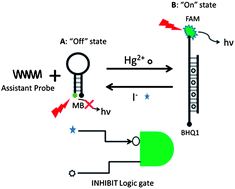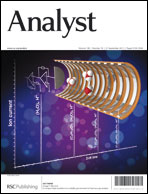A reversible fluorescent logic gate for sensing mercury and iodide ions based on a molecular beacon
Abstract
A simple, rapid, and reversible fluorescent DNA INHIBIT logic gate has been developed for sensing mercury (Hg2+) and iodide (I−) ions based on a molecular beacon (MB). In this logic gate, a mercury ion was introduced as the first input into the MB logic gate system to assist in the hybridization of the MB with an assistant DNA probe through the thymine–Hg2+–thymine interaction, which eventually restored the fluorescence of MB as the output. With this signal-on process, mercury ions can be detected with a limit of detection as low as 7.9 nM. Furthermore, when iodide ions were added to the Hg2+/MB system as the second input, the fluorescence intensity decreased because Hg2+ in the thymine–Hg2+–thymine complex was grabbed by I− due to a stronger binding force. Iodide ions can be detected with a limit of detection of 42 nM. Meanwhile, we studied the feasibility and basic performance of the DNA INHIBIT logic gate, optimized the logic gate conditions, and investigated its sensitivity and selectivity. The results showed that the MB based logic gate is highly selective and sensitive for the detection of Hg2+ and I− over other interfering


 Please wait while we load your content...
Please wait while we load your content...